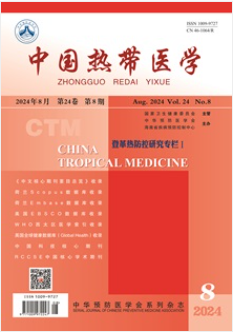重庆市荣昌区HIV/AIDS患者自相关及时空聚类分析
引用次数: 0
摘要
目的分析重庆市荣昌区2014 - 2019年人类免疫缺陷病毒(HIV)/获得性免疫缺陷综合征(AIDS)患者的时空分布及聚集特征,为相关部门明确艾滋病防控重点,合理配置医疗卫生资源提供参考。方法选择2014 - 2019年荣昌地区新发现的HIV/AIDS病例,并从全国HIV/AIDS综合信息系统中获取。将数据输入GeoDa 0.95i软件进行空间经验贝叶斯平滑和自相关分析,将数据输入Satscan 9.3软件进行空间扫描统计分析,最后利用地理信息系统进行可视化处理。结果2014-2019年荣昌区共报告艾滋病新发病例1 476例。各年度报告年龄≥50岁病例所占比例为58.74% ~ 68.92%,且呈逐年上升趋势(χ 2趋势= 4.524,P = 0.033)。各年度HIV/AIDS报告率的空间分布呈正相关(Moran’s I > 0, P0, P<0.05)。局域空间自相关和时空扫描统计量综合分析显示城区(昌元街道,昌州街道)和邻近的峰高街道,万灵镇,直升镇等乡镇(街)道为荣昌区艾滋病流行地区。结论荣昌区艾滋病新发病例在地理空间分布上存在聚集性,各级政府应重点加强城区和邻近城乡结合部热点区域流动人口艾滋病毒的监测以及中老年人群和低档暗娼人群艾滋病的干预力度,同时进一步规范各级医疗机构艾滋病随访管理工作,防止热点区域的扩大和艾滋病毒/艾滋病的蔓延。本文章由计算机程序翻译,如有差异,请以英文原文为准。
Autocorrelation and spatiotemporal clusters of HIV/AIDS patients in Rongchang District, Chongqing
Objective To analyze the spatiotemporal distribution and clusters characteristics of human
immunodeficiency virus (HIV)/acquired immune deficiency syndrome (AIDS) patients in
Rongchang District of Chongqing from 2014 to 2019, we provide reference for relevant
departments to clarify the focus of AIDS prevention and control and rationally allocate
medical and health resources.
Methods Newly identified HIV/AIDS in Rongchang Area from 2014 to 2019 were selected from
the National HIV/AIDS Comprehensive Information System. We inputted data into GeoDa
0.95i software for carry out spatial empirical bayesian smoothing and autocorrelation
analysis, and into Satscan 9.3 software for statistical analysis of spatial scanning,
and finally geographic information system was used for visualization.
Results A total of 1 476 new cases of HIV/AIDS were reported in Rongchang District during
2014–2019. The proportion of cases over the aged ≥50 years reported in each year ranged
from 58.74% to 68.92%, and increased year by year (χ
2
trend = 4.524, P = 0.033). There was a positive spatial autocorrelation in the spatial distribution
of the HIV/AIDS reporting rate for each year (Moran’s I > 0, P<0.05). The areas with the most serious HIV/AIDS epidemics, including urban areas
(Changyuan Street, Changzhou Street) and the neighboring Fenggao Street, Wanling Town,
Zhisheng Town and other towns (streets) in the east were Rongchang AIDS-endemic areas,
were identified with both the local Moran’s I index and spatiotemporal scan statistics.
Conclusion Geographical differences and spatial clustering were identified in HIV/AIDS cases
in Rongchang District. For the further prevention and control of the hot-spot regions
expanding, the government must strengthen monitoring of the migrating population in
hotspots, and strengthen AIDS interventions for middle-aged and elderly people and
low-fee sex workers, while further standardize the follow-up management of AIDS in
medical institutions at all levels.
摘要:目的 了解2014—2019年重庆市荣昌区艾滋病病毒 (
human immunodeficiency virus, HIV) 感染者和艾滋病 (acquired immune deficiency syndrome, AIDS) 病人(简称HIV/AIDS)的时空分布和聚类特征,
为相关部门明确艾滋病防 控重点及合理配置医疗卫生资源提供参考依据。
方法 在全国艾滋病综合防治信息系统选择2014—2019年现住址为 重庆市荣昌区的HIV/AIDS新发病例信息,导人GeoDa 0.95i软件进行空间经验贝叶斯平滑和空间自相关分析,
导人 Satscan 9.3软件进行时空扫描分析;采用地理信息系统(GIS)实现结果的可视化展示。
结果 2014—2019年, 荣昌区累 计报告HIV/AIDS新发病例1 476例, 各年报告的≥50岁病例数占全部病例的58.74% ~ 68.92%,, 并呈逐年上升趋势
(χ
2
趋势=4.524, P=0.033)。各年HIV/AIDS报告率空间分布均存在正向自相关性 (Moran’s I>0, P<0.05) 。局域空间自相 关和时空扫描统计量综合分析显示城区(昌元街道、昌州街道)和邻近的峰高街道、万灵镇、直升镇等乡镇 (街道)为荣 昌区AIDS流行地区。
结论 荣昌区HIV/AIDS新发病例在地理空间分布上存在聚集性, 各级政府应重点加强城区和邻 近城乡结合部热点区域流动人口 HIV的监测以及中老年人群和低档暗娼人群艾滋病的干预力度,
同时进一步规范各 级医疗机构艾滋病随访管理工作, 防止热点区域的扩大和HIV/AIDS的蔓延。
求助全文
通过发布文献求助,成功后即可免费获取论文全文。
去求助
来源期刊
CiteScore
0.60
自引率
0.00%
发文量
13927
期刊介绍:
China Tropical Medicine, was approved by the Ministry of Science and Technology in 2001, is the only tropical medicine periodical under the charge of the National Health Commission of China. It’s organized by Hainan Provincial Center for Disease Prevention and Control, and Chinese Preventive Medicine Association.
The journal is indexed by the following database: Scopus database, Embase database, EBSCO Database, The Western Pacific Region index medicus (WPRIM), American Chemical Abstracts (CA), International Centre for Agricultural and Biological Sciences Research Database (CABI), Global Health Database, Database of the Ulrich's Periodicals Directory, China Science and Technology Core Journals, China Core Journals (Selection) Database, Database of Chinese Biomedical Literature, Comprehensive Evaluation Database of Chinese Academic Journals, CAJCD Code of Conduct Excellent Journal, Database of Chinese SCI-Tech Periodicals, China Journal Full Text Database.

 求助内容:
求助内容: 应助结果提醒方式:
应助结果提醒方式:


